Chapter 21
Lakadou

Make a sonorous knock-off of Timor-Leste’s amazing bamboo stringed instrument. CREDIT: Ros Dunlop
Timor-Leste is home to several interesting musical instruments, among them the lakadou, which would fit somewhere between the string section and the percussion section in an orchestra. The cords stretched from end to end of the huge bamboo section are actually the skin of the bamboo itself, carefully cut and lifted out, and held to vibrate above the main tube by small bits of sticks at either end. The incredible part to me is how it is tunable by pressing on the stick bits. You strum it with another chip of bamboo or coconut shell, and it’s a trick to strum in a way that hits many of the stretched strips. Then you get another person to tap out a rhythm on one end with two small sticks.
The strips cover maybe two-thirds of the circumference of the bamboo tube. At one end of the lakadou the section division of the bamboo seals the air inside, and the other end is open to be controlled by your hand. There’s a hole on the underside halfway down that you can open and close against your belly to give subtle changes to the tones produced.
Such hefty bamboo is not easily found, even here, but a while back we realized we can make a fake version of the lakadou with string and a cardboard tube. We were surprised at how nice the sound is. Check it out.
Gather stuff
- Fat cardboard tube, maybe 40 or 50 cm long
- Strong, thin string

CREDIT: Ros Dunlop
- Small sticks, like chopsticks, ¼-inch dowels, or pencils
- Pick, store-bought or cut from an old credit card
Gather tools
- Hacksaw or cross-cut wood saw
- Scissors
- Side cutters
Tinker
Start by cutting the tube around 40 cm long with a hacksaw or small-toothed wood saw. Longer tubes will make deeper pitched sounds.
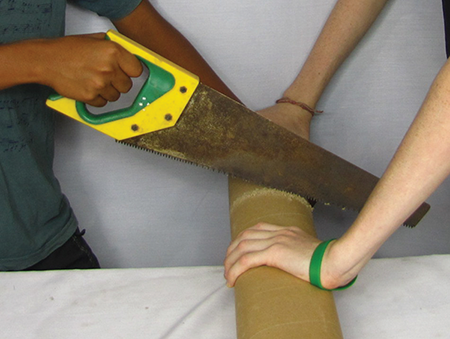
With the hacksaw, cut 1-cm slits on either end, directly aligned with each other. We started with five on either end. You can always add more later.

Cut a piece of string maybe twice as long as the tube and make a knot at one end. Any big, fat knot will work. Pull it tight and slide the string into one of the slits so that the knot gets stuck on the inside of the tube. Here I’ll show the process for the second string; they’ll all be the same.
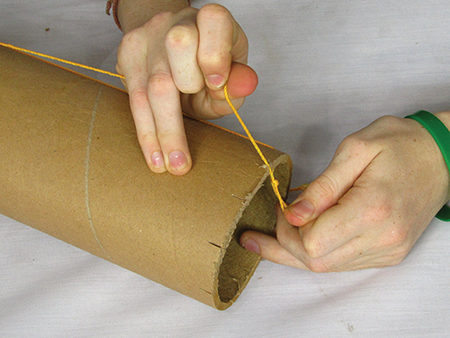
At the other end, pull the string to the corresponding slit. Form the knot and move it to a position just short of the slit.

Now pull like crazy so that the knot goes over the edge and the string falls down into the slot. The knot gets stuck on the inside.
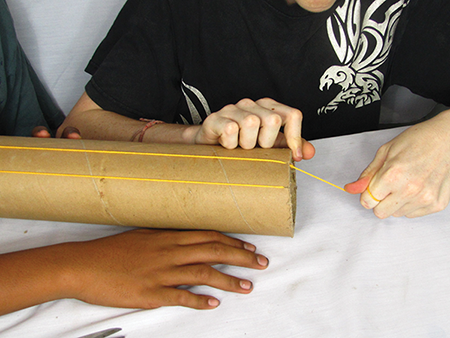
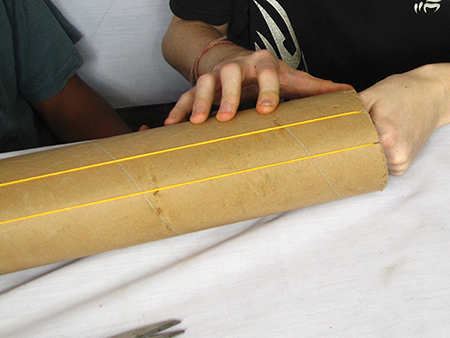
Mount strings for all your slits.
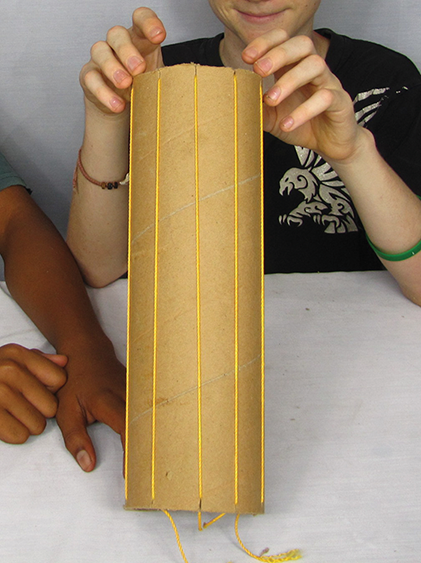
Next, cut out your small stick bits. We sacrificed a pencil, which works well because it has flat edges due to the hexagonal shape. You could cut it with side cutters just as well.

Jam one bit under each end of each string and cut out your pick, and you’re ready to go.
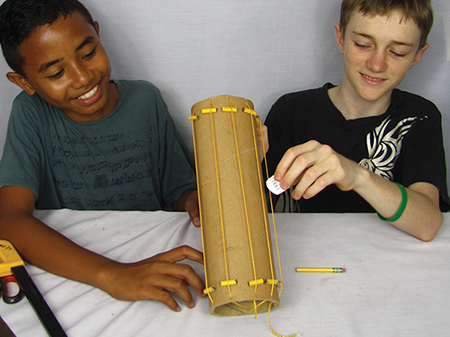
We didn’t bother hacking a hole in the sidewall or covering one end, but you could. When you play it, you can cover one end with your belly and then open and close the other end with your hand to see what different sounds you can make.
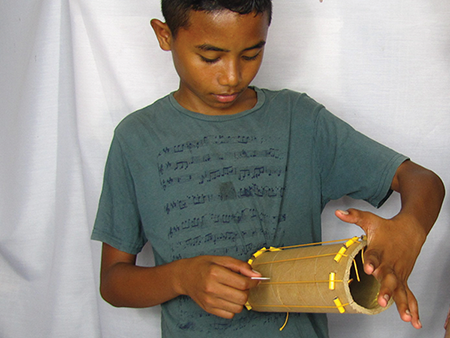
Jamming the sticks in or letting them out changes the pitch of each string. Sometimes the stick bits slip down. We solved that problem by rubbing a hot-glue stick where the stick sits on the tube to increase friction. This kept ours in place.

We made another one with two different lengths of string on a notched tube. Zowie!

As fantastic as we sound, the Timor talent scouts haven’t found us yet.

What’s Going On?
Sound comes from something vibrating. In the case of musical instruments, usually the whole thing is eventually vibrating, but there is always an original vibrator. In this case it’s the strings, representing the bamboo skin strips. They are stretched tightly, and when you pluck one, it goes back to its original position, keeps going due to momentum until it tightens up on the other side, and then heads back to the original position. But then it can’t stop again and goes back to where it was released from the pluck, and then it starts the whole thing over again. It vibrates, in other words.
If it vibrates fast, it makes a high-pitched sound, and vibrating slowly makes a low-pitched sound. Three easy tweaks increase the speed of the string’s vibration: stretch it tighter, make it lighter, and cut it shorter. Tweak vice versa to make the vibration slower: let it looser, make it heavier, and cut it longer. Try all of these on your lakadou, and also on your guitar if you have one. To make a string heavier, you usually have to get another one, maybe a used steel guitar string.
High and low pitch is about a sound’s frequency. Loud and soft is about a sound’s amplitude. If you hammer hard on something, it will vibrate more violently and make a louder sound. Play gentle and you have a soft sound. And there’s some science of the music coming from your lakadou!
